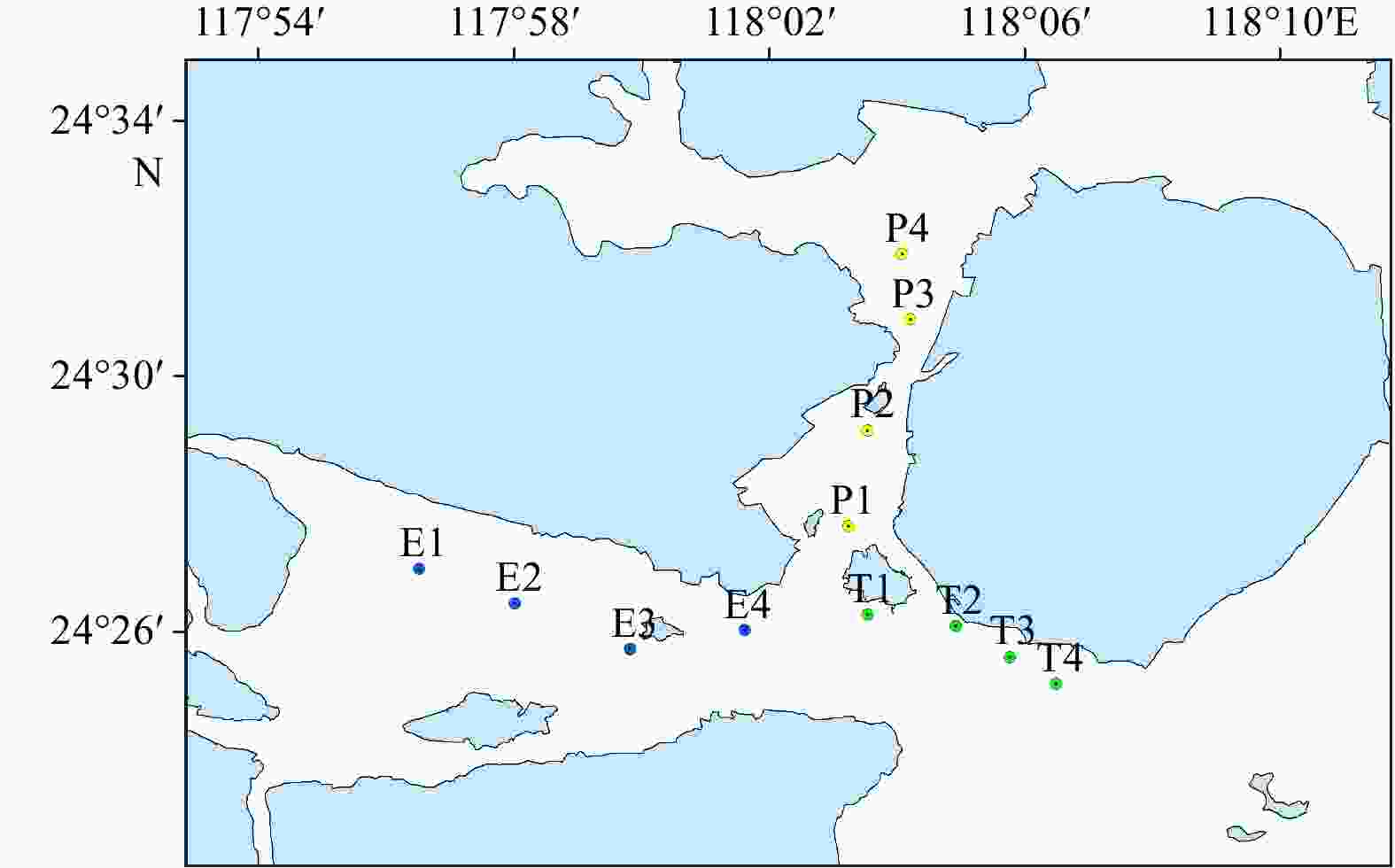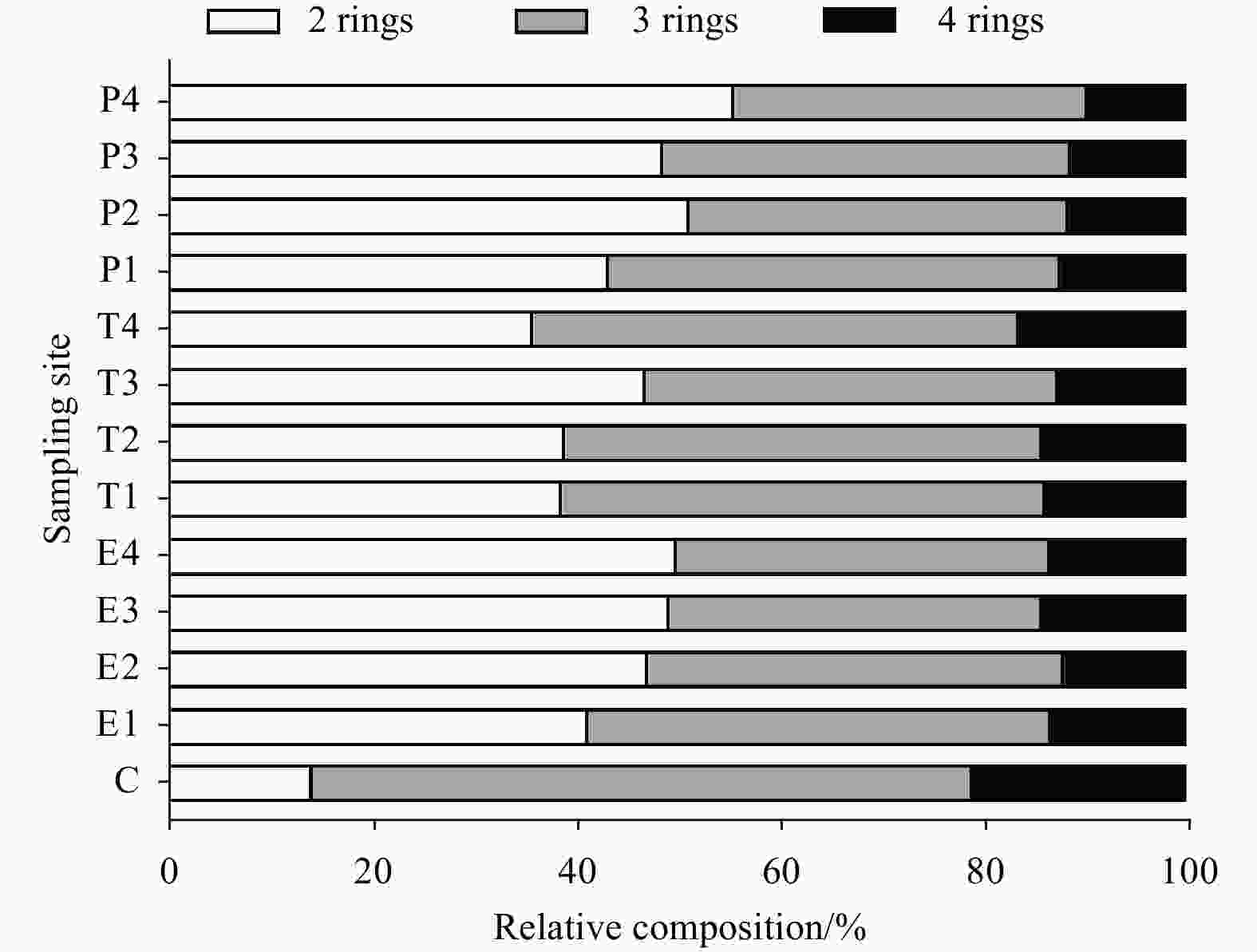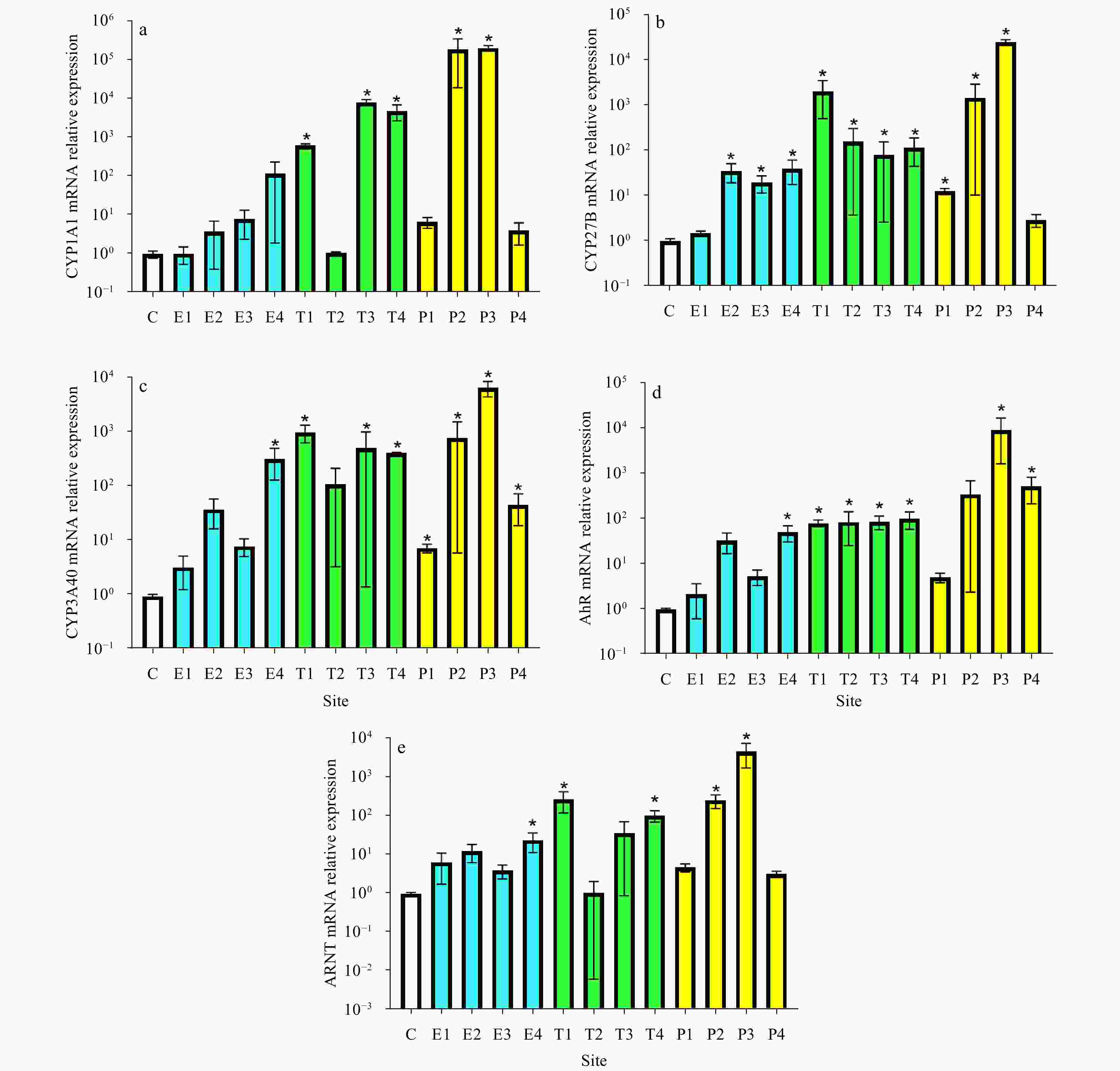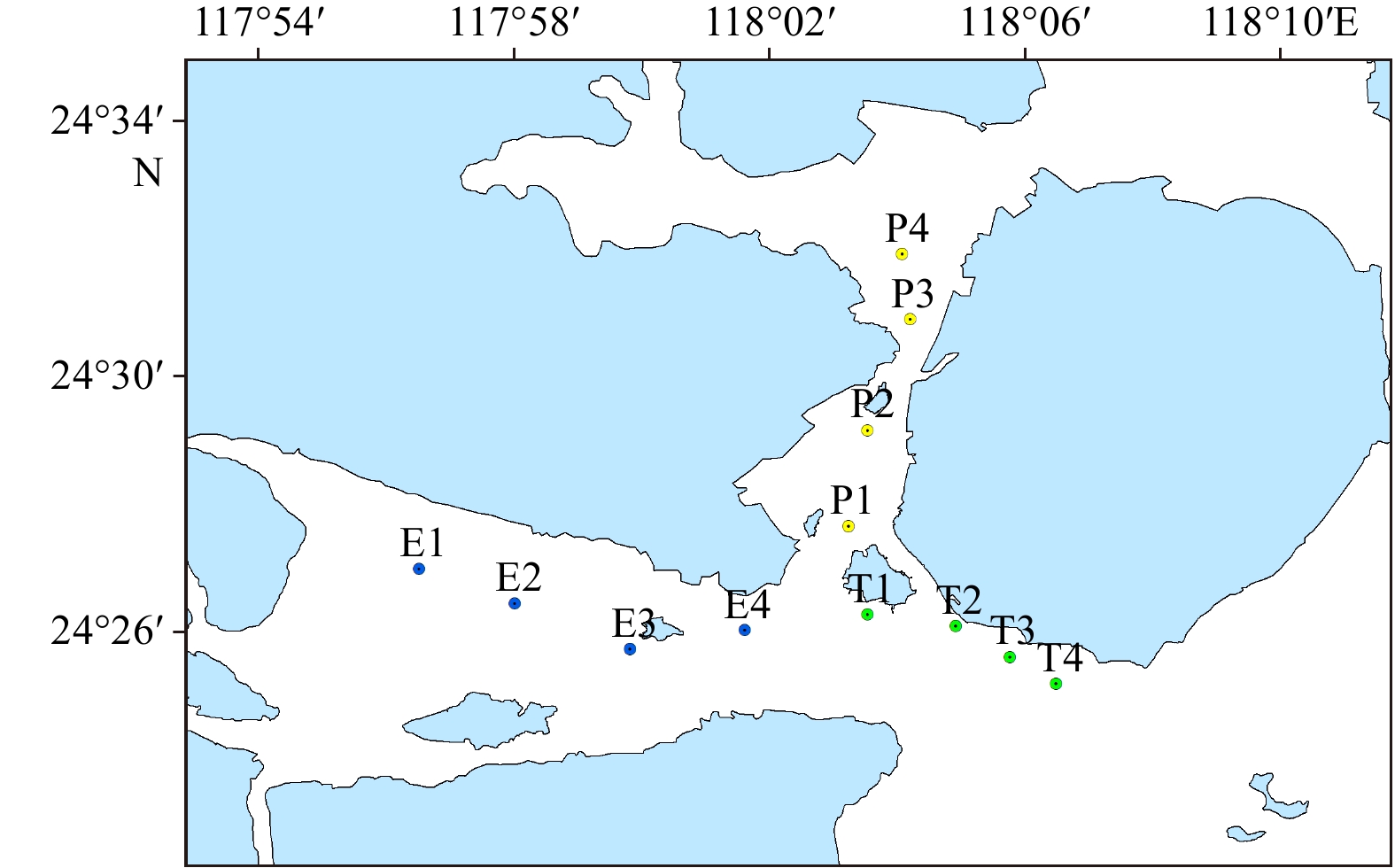An innovative classification system for ranking the biological effects of marine aromatic hydrocarbons based on fish embryotoxicity
-
Abstract: Petroleum hydrocarbon pollution is a global concern, particularly in coastal environments. Polycyclic aromatic hydrocarbons (PAHs) are regarded as the most toxic components of petroleum hydrocarbons. In this study, the biomonitoring and ranking effects of petroleum hydrocarbons and PAHs on the marine fish model Oryzias melastigma embryos were determined in the Jiulong River Estuary (JRE) and its adjacent waters in China. The results showed that the levels of petroleum hydrocarbons from almost all sites met the primary standard for marine seawater quality, and the concentrations of the 16 priority PAHs in the surface seawater were lower compared with those in other coastal areas worldwide. A new fish expert system based on the embryotoxicity of O. melastigma (OME-FES) was developed and applied in the field to evaluate the biological effects of petroleum hydrocarbons and PAHs. The selected physiological index and molecular indicators in OME-FES were appropriate biomarkers for indicating the harmful effects of petroleum hydrocarbons and PAHs. The outcome of OME-FES revealed that the biological effect levels of the sampling sites ranged from level Ⅰ (no stress) to level Ⅲ (medium stress), which is further corroborated by the findings of nested analysis of variance (ANOVA) models. Our results suggest that the OME-FES is an effective tool for evaluating and ranking the biological effects of marine petroleum hydrocarbons and PAHs. This method may also be applied to evaluate other marine pollutants based on its framework.
-
Figure 3. Relative mRNA expression levels of five target genes in the embryos treated with surface seawater samples at different sites compared with the control after 4 d exposure. Data are expressed as the mean ± standard error. Significant differences were accepted at * p < 0.05. Five biological replicates were conducted.
Table 1. Determination of the alteration level (AL)
Decreasing
parameterIncreasing and
bell-shaped parameterBiological relevance Threshold AL Threshold AL AF > 0.8 NA AF < 1.2 NA Small differences (±20%) with respect to controls; although statistically significant, they are not considered of biological relevance. AF < 0.8 − AF > 1.2 + Larger than 20%, statistically significant differences with respect to controls. The symbols “−” and “+” indicate decreased or increased physiological responses of the organisms, respectively. AF < 0.5 − − AF > 2.0 ++ Large differences (>100%) with respect to controls. The symbols “−−” and “++” indicate moderate decreased or increased physiological responses of the organisms, respectively, which are within the range of alterations induced by moderate natural stressors. Note: AF, alteration factor; NA, no alteration. Table 2. Summary results of nested ANOVA analyses for IBRv2 values
Source DF SS MS F p Study areas 2 135.869 67.935 1811.151 0.000 E-T 1 93.268 93.268 4198.732 0.000 E-P 1 112.483 112.483 2134.084 0.000 T-P 1 2.273 2.273 57.537 0.000 Note: E, the estuary area; T, the tourism area; P, the port area; DF, degrees of freedom for each component; SS, the sum-of-squares; MS, the mean-squares; F and p for the hypothesis test of significant study area heterogeneity. Table 3. Response profiles of the biomarkers selected in OME-FES and their levels of biological organization
Biomarker Response profile Level of biological organization CYP1A1 gene increasing molecular/cellular CYP27B gene increasing molecular/cellular CYP3A40 gene increasing molecular/cellular AhR gene increasing molecular/cellular ARNT gene increasing molecular/cellular BSD score increasing tissue Survival rate decreasing organism Table 4. Critical values of five selected biomarkers and the threshold values of BEI
Control $\beta $ = 1.20 $\beta $ = 2.00 CYP1A1 gene 1.00 1.20 2.00 CYP27B gene 1.00 1.20 2.00 CYP3A40 gene 1.00 1.20 2.00 AhR gene 1.00 1.20 2.00 ARNT gene 1.00 1.20 2.00 Threshold values of BEI 0.00 2.54 9.65 Note: $\beta $: biomarkers and threshold values selected according to the alteration factor in Table 1 and response profiles of the molecular biomarkers in Table 3. Table 5. Concentrations (ng/L) of
$\Sigma $ PAHs in coastal waters from different areas worldwideSampling area Number of PAHs n Mean Min Max Reference JRE and its adjacent waters 16 12 31.0 20.22 38.71 this study Langkawi Island, Malaysia 18 − − 18.0 46.0 Zong et al., 2014 Natuna, Indonesia 17 − − 0.0 5.8 Zong et al., 2014 Oostende, Belgium 15 − − 13.0 24.0 Zong et al., 2014 Chesapeake Bay, USA 17 38 33.3 20.0 65.6 Zhou and Maskaoui, 2003 Dalian coastal area, China 9 17 60.8 50.5 74.7 Zhang et al., 2020 Maowei Sea, China 16 10 − 33.5 48.5 Zheng et al., 2022 Western Taiwan Strait, China 15 31 19.8 12.3 58.0 Wu et al., 2011 Xiamen Bay, China 16 17 17.0 7.0 26.9 Maskaoui et al., 2002 JRE, China-wet season 46 20 67.1 24.6 125.9 Wu et al., 2019 JRE, China-dry season 46 20 27.4 17.5 65.0 Wu et al., 2019 Thane creek, India 16 10 − 337 706 Tiwari et al., 2017 Persian Gulf, Iran 30 360 464 70 884 Jafarabadi et al., 2017 Aegina Island, Greece 17 − − 103 124 Zong et al., 2014 Dalian coast, China-winter 46 15 357 136 621 Hong et al., 2016 Dalian coast, China-summer 46 15 297 65 1 130 Hong et al., 2016 Luan River Estuary, China 14 9 − 231 3 664 Yan et al., 2016 Hai River Estuary, China 14 11 − 288 3 797 Yan et al., 2016 Zhangweixin River Estuary, China 15 10 − 306 7 597 Yan et al., 2016 Note: JRE: Jiulong River Estuary; n denominates the number of samples; − represents no data. -
Bo Jun, Cai Ling, Xu Jiahe, et al. 2011. The marine medaka Oryzias melastigma—a potential marine fish model for innate immune study. Marine Pollution Bulletin, 63(5–12): 267–276, doi: 10.1016/j.marpolbul.2011.05.014 Bo Jun, Giesy J P, Ye Rui, et al. 2012. Identification of differentially expressed genes and quantitative expression of complement genes in the liver of marine medaka Oryzias melastigma challenged with Vibrio parahaemolyticus. Comparative Biochemistry and Physiology Part D: Genomics and Proteomics, 7(2): 191–200, doi: 10.1016/j.cbd.2012.02.005 Bo Jun, Zheng Ronghui, Kuang Weiming, et al. 2017. The use of rockfish Sebastiscus marmoratus as a sentinel species to assess petroleum hydrocarbons pollution: A case study in Quanzhou Bay, China. Marine Pollution Bulletin, 124(2): 984–992, doi: 10.1016/j.marpolbul.2017.01.025 Brack W, Aissa S A, Backhaus T, et al. 2019. Effect-based methods are key. The European Collaborative Project SOLUTIONS recommends integrating effect-based methods for diagnosis and monitoring of water quality. Environmental Sciences Europe, 31(1): 10, doi: 10.1186/s12302-019-0192-2 Carls M G, Holland L, Larsen M, et al. 2008. Fish embryos are damaged by dissolved PAHs, not oil particles. Aquatic Toxicology, 88(2): 121–127, doi: 10.1016/j.aquatox.2008.03.014 Chau K W. 2006. Persistent organic pollution characterization of sediments in Pearl River estuary. Chemosphere, 64(9): 1545–1549, doi: 10.1016/j.chemosphere.2005.11.060 Chen Jincan, Chen Mengyun, Fang Chao, et al. 2020. Microplastics negatively impact embryogenesis and modulate the immune response of the marine medaka Oryzias melastigma. Marine Pollution Bulletin, 158: 111349, doi: 10.1016/j.marpolbul.2020.111349 Chen Jincan, Fang Chao, Zheng Ronghui, et al. 2022. Environmentally relevant concentrations of microplastics modulated the immune response and swimming activity, and impaired the development of marine medaka Oryzias melastigma larvae. Ecotoxicology and Environmental Safety, 241: 113843, doi: 10.1016/j.ecoenv.2022.113843 Chen Nengwang, Wu Yinqi, Wu Jiezhong, et al. 2014. Natural and human influences on dissolved silica export from watershed to coast in Southeast China. Journal of Geophysical Research: Biogeosciences, 119(1): 95–109, doi: 10.1002/2013JG002429 Cristiano W, Lacchetti I, Di Domenico K, et al. 2020. Application of effect-based methods (EBMs) in a river basin: A preliminary study in Central Italy. Annali dell'Istituto Superiore di Sanità, 56(1): 114–121 Dagnino A, Allen J I, Moore M N, et al. 2007. Development of an expert system for the integration of biomarker responses in mussels into an animal health index. Biomarkers, 12(2): 155–172, doi: 10.1080/13547500601037171 Dong Sijun, Kang Mei, Wu Xinlong, et al. 2014. Development of a promising fish model (Oryzias melastigma) for assessing multiple responses to stresses in the marine environment. BioMed Research International, 2014: 563131 Escher B I, Aїt-Aїssa S, Behnisch P A, et al. 2018. Effect-based trigger values for in vitro and in vivo bioassays performed on surface water extracts supporting the environmental quality standards (EQS) of the European Water Framework Directive. Science of the Total Environment, 628–629: 748–765 Fang Chao, Bo Jun, Zheng Ronghui, et al. 2020. Biomonitoring of aromatic hydrocarbons in clam Meretrix meretrix from an emerging urbanization area, and implications for human health. Ecotoxicology and Environmental Safety, 192: 110271, doi: 10.1016/j.ecoenv.2020.110271 Fiorino E, Sehonova P, Plhalova L, et al. 2018. Effects of glyphosate on early life stages: comparison between Cyprinus carpio and Danio rerio. Environmental Science and Pollution Research, 25(9): 8542–8549, doi: 10.1007/s11356-017-1141-5 Gao Xiang, Ding Guanghui, Li Xishan, et al. 2018. Comparison of toxicity effects of fuel oil treated by different dispersants on marine medaka (Oryzias melastigma) embryo. Acta Oceanologica Sinica, 37(11): 123–132, doi: 10.1007/s13131-018-1255-8 Gong Guanqun, 2009. Study of water particle motion and water exchange simulation in Xiamen Bay (in Chinese)[dissertation]. Xiamen: Xiamen University Guo Zhouhua, Wang Cui, Yan Li, et al. 2012. Spatiotemporal variations of main pollutants in Jiulongjiang Estuary. China Environmental Science (in Chinese), 32(4): 679–686 Hong Wenjun, Jia Hongliang, Li Yifan, et al. 2016. Polycyclic aromatic hydrocarbons (PAHs) and alkylated PAHs in the coastal seawater, surface sediment and oyster from Dalian, Northeast China. Ecotoxicology and Environmental Safety, 128: 11–20, doi: 10.1016/j.ecoenv.2016.02.003 Horie Y, Takahashi C. 2021. Development of an in vivo acute bioassay using the marine medaka Oryzias melastigma. Environmental Monitoring and Assessment, 193(11): 725, doi: 10.1007/s10661-021-09527-8 Jafarabadi A R, Bakhtiari A R, Toosi A S. 2017. Comprehensive and comparative ecotoxicological and human risk assessment of polycyclic aromatic hydrocarbons (PAHs) in reef surface sediments and coastal seawaters of Iranian Coral Islands, Persian Gulf. Ecotoxicology and Environmental Safety, 145: 640–652, doi: 10.1016/j.ecoenv.2017.08.016 Kong R Y C, Giesy J P, Wu R S S, et al. 2008. Development of a marine fish model for studying in vivo molecular responses in ecotoxicology. Aquatic Toxicology, 86(2): 131–141, doi: 10.1016/j.aquatox.2007.10.011 Li Guoliang, Lang Yinhai, Gao Maosheng, et al. 2014. Carcinogenic and mutagenic potencies for different PAHs sources in coastal sediments of Shandong Peninsula. Marine Pollution Bulletin, 84(1–2): 418–423, doi: 10.1016/j.marpolbul.2014.04.039 Maier D, Blaha L, Giesy J P, et al. 2015. Biological plausibility as a tool to associate analytical data for micropollutants and effect potentials in wastewater, surface water, and sediments with effects in fishes. Water Research, 72: 127–144, doi: 10.1016/j.watres.2014.08.050 Maskaoui K, Zhou J L, Hong Huasheng, et al. 2002. Contamination by polycyclic aromatic hydrocarbons in the Jiulong River Estuary and Western Xiamen Sea, China. Environmental Pollution, 118(1): 109–122, doi: 10.1016/S0269-7491(01)00208-1 Mcintosh S, King T, Wu Dongmei, et al. 2010. Toxicity of dispersed weathered crude oil to early life stages of Atlantic herring (Clupea harengus). Environmental Toxicology and Chemistry, 29(5): 1160–1167, doi: 10.1002/etc.134 Mohammed A. 2013. Why are early life stages of aquatic organisms more sensitive to toxicants than adults?. In: Gowder S, ed. New Insights into Toxicity and Drug Testing. London: IntechOpen, 49–62 Mu Jingli, Wang Ying, Wang Xinhong, et al. 2011. Toxic effects of cadmium, mercury, chromium and lead on the early life stage of marine medaka (Oryzias melastigma). Asian Journal of Ecotoxicology (in Chinese), 6(4): 352–360 National Environmental Protection Administration. 2004. GB 3097–1997 Sea water quality standard (in Chinese). Beijing: Environmental Science Press Pannetier P, Morin B, Le Bihanic F, et al. 2020. Environmental samples of microplastics induce significant toxic effects in fish larvae. Environment International, 134: 105047, doi: 10.1016/j.envint.2019.105047 Pasparakis C, Esbaugh A J, Burggren W, et al. 2019. Impacts of deepwater horizon oil on fish. Comparative Biochemistry and Physiology Part C: Toxicology & Pharmacology, 224: 108558 Reynaud S, Raveton M, Ravanel P. 2008. Interactions between immune and biotransformation systems in fish: a review. Aquatic Toxicology, 87(3): 139–145, doi: 10.1016/j.aquatox.2008.01.013 Reynolds W J, Feist S W, Jones G J, et al. 2003. Comparison of biomarker and pathological responses in flounder (Platichthys flesus L. ) induced by ingested polycyclic aromatic hydrocarbon (PAH) contamination. Chemosphere, 52(7): 1135–1145, doi: 10.1016/S0045-6535(03)00332-1 Sanchez W, Burgeot T, Porcher J M. 2013. A novel “integrated biomarker response” calculation based on reference deviation concept. Environmental Science and Pollution Research, 20(5): 2721–2725, doi: 10.1007/s11356-012-1359-1 Sun Runxia, Qin Lin, Ke Changliang, et al. 2016. Polycyclic aromatic hydrocarbons in surface sediments and marine organisms from the Daya Bay, South China. Marine Pollution Bulletin, 103(1–2): 325–332, doi: 10.1016/j.marpolbul.2016.01.009 Tamura I, Yasuda Y, Kagota K I, et al. 2017. Contribution of pharmaceuticals and personal care products (PPCPs) to whole toxicity of water samples collected in effluent-dominated urban streams. Ecotoxicology and Environmental Safety, 144: 338–350, doi: 10.1016/j.ecoenv.2017.06.032 Tiwari M, Sahu S K, Pandit G G. 2017. Distribution of PAHs in different compartment of creek ecosystem: Ecotoxicological concern and human health risk. Environmental Toxicology and Pharmacology, 50: 58–66, doi: 10.1016/j.etap.2017.01.008 Wan Ru, Meng Fanping, Su Enping, et al. 2018. Development of a classification scheme for evaluating water quality in marine environment receiving treated municipal effluent by an integrated biomarker approach in Meretrix meretrix. Ecological Indicators, 93: 697–703, doi: 10.1016/j.ecolind.2018.05.062 Wang Weili, Lin Cai, Wang Lingqing, et al. 2021. Effects of human activities on the spatial distribution, ecological risk and sources of PTEs in coastal sediments. International Journal of Environmental Research and Public Health, 18(23): 12476, doi: 10.3390/ijerph182312476 Wei Shanshan. 2014. Study on present situation and tendency of water quality of main estuary in Fujian Province. Environmental Science and Management (in Chinese), 39(10): 37–42 Wernersson A S, Carere M, Maggi C, et al. 2015. The European technical report on aquatic effect-based monitoring tools under the water framework directive. Environmental Sciences Europe, 27(1): 7, doi: 10.1186/s12302-015-0039-4 Wittlerová M, Jírová G, Vlková A, et al. 2020. Sensitivity of zebrafish (Danio rerio) embryos to hospital effluent compared to Daphnia magna and Aliivibrio fischeri. Physiological Research, 69(Suppl4): S681–S691 Wu Gaojie, Cao Wenzhi, Huang Zheng, et al. 2017. Decadal changes in nutrient fluxes and environmental effects in the Jiulong River Estuary. Marine Pollution Bulletin, 124(2): 871–877, doi: 10.1016/j.marpolbul.2017.01.071 Wu Dongmei, Wang Zhendi, Hollebone B, et al. 2012. Comparative toxicity of four chemically dispersed and undispersed crude oils to rainbow trout embryos. Environmental Toxicology and Chemistry, 31(4): 754–765, doi: 10.1002/etc.1739 Wu Yuling, Wang Xinhong, Li Yongyu, et al. 2011. Occurrence of polycyclic aromatic hydrocarbons (PAHs) in seawater from the Western Taiwan Strait, China. Marine Pollution Bulletin, 63(5–12): 459–463, doi: 10.1016/j.marpolbul.2011.03.008 Wu Yuling, Wang Xinhong, Ya Miaolei, et al. 2016. Distributions of organochlorine compounds in sediments from Jiulong River estuary and adjacent western Taiwan Strait: implications of transport, sources and inventories. Environmental Pollution, 219: 519–527, doi: 10.1016/j.envpol.2016.05.081 Wu Yuling, Wang Xinhong, Ya Miaolei, et al. 2019. Seasonal variation and spatial transport of polycyclic aromatic hydrocarbons in water of the subtropical Jiulong River watershed and estuary, Southeast China. Chemosphere, 234: 215–223, doi: 10.1016/j.chemosphere.2019.06.067 Yan Jinxia, Liu Jingling, Shi Xuan, et al. 2016. Polycyclic aromatic hydrocarbons (PAHs) in water from three estuaries of China: distribution, seasonal variations and ecological risk assessment. Marine Pollution Bulletin, 109(1): 471–479, doi: 10.1016/j.marpolbul.2016.05.025 Yan Xiuli, Zhai Weidong, Hong Huasheng, et al. 2012. Distribution, fluxes and decadal changes of nutrients in the Jiulong River estuary, Southwest Taiwan Strait. Chinese Science Bulletin, 57(18): 2307–2318, doi: 10.1007/s11434-012-5084-4 Yeo B G, Takada H, Hosoda J, et al. 2017. Polycyclic Aromatic Hydrocarbons (PAHs) and hopanes in plastic resin pellets as markers of oil pollution via international pellet watch monitoring. Archives of Environmental Contamination and Toxicology, 73(2): 196–206, doi: 10.1007/s00244-017-0423-8 Yu Ziling, Lin Qin, Gu Yangguang, et al. 2016. Spatial–temporal trend and health implications of polycyclic aromatic hydrocarbons (PAHs) in resident oysters, South China Sea: a case study of Eastern Guangdong coast. Marine Pollution Bulletin, 110(1): 203–211, doi: 10.1016/j.marpolbul.2016.06.061 Zeng Xiangfeng, Chen Xijuan, Zhuang Jie. 2015. The positive relationship between ocean acidification and pollution. Marine Pollution Bulletin, 91(1): 14–21, doi: 10.1016/j.marpolbul.2014.12.001 Zhang Yuting, Chen Mengyun, He Shuiqing, et al. 2021. Microplastics decrease the toxicity of triphenyl phosphate (TPhP) in the marine medaka (Oryzias melastigma) larvae. Science of the Total Environment, 763: 143040, doi: 10.1016/j.scitotenv.2020.143040 Zhang Lemeng, Dong Xiaocui, Wang Chonggang, et al. 2017. Bioaccumulation and the expression of hepatic cytochrome P450 genes in marine medaka (Oryzias melastigma) exposed to difenoconazole. Journal of Environmental Sciences, 52: 98–104, doi: 10.1016/j.jes.2016.03.011 Zhang Lili, Li Qian, Chen Ling, et al. 2015. Toxicity of surface water from Huangpu River to luminous bacteria (Vibrio qinghaiensis SP. Q67) and zebrafish (Danio rerio) embryos. Ecotoxicology and Environmental Safety, 112: 137–143, doi: 10.1016/j.ecoenv.2014.10.037 Zhang Lijie, Wang Yan, Tan Feng, et al. 2020. Tidal variability of polycyclic aromatic hydrocarbons and organophosphate esters in the coastal seawater of Dalian, China. Science of the Total Environment, 708: 134441, doi: 10.1016/j.scitotenv.2019.134441 Zhang Zhendong, Yan Qilun. 2014. Comparative toxicity of different crude oils on the cardiac function of marine medaka (Oryzias melastigma) embryo. International Journal Bioautomation, 18(4): 389–396 Zheng Ronghui, Fang Chao, Hong Fukun, et al. 2021. Developing and applying a classification system for ranking the biological effects of endocrine disrupting chemicals on male rockfish Sebastiscus marmoratus in the Maowei Sea, China. Marine Pollution Bulletin, 163: 111931, doi: 10.1016/j.marpolbul.2020.111931 Zheng Ronghui, Fang Chao, Hong Fukun, et al. 2022. Applying a fish expert system for ranking the biological effects of polycyclic aromatic hydrocarbons on the rockfish Sebastiscus marmoratus in the Maowei Sea, China. Acta Oceanologica Sinica, 41(12): 105–114, doi: 10.1007/s13131-022-2033-1 Zhou J L, Maskaoui K. 2003. Distribution of polycyclic aromatic hydrocarbons in water and surface sediments from Daya Bay, China. Environmental Pollution, 121(2): 269–281, doi: 10.1016/S0269-7491(02)00215-4 Zhou Yixi, Shen Chao, Ruan Jinpeng, et al. 2020. Generation and application of a Tg(cyp1a: egfp) transgenic marine medaka (Oryzias melastigma) line as an in vivo assay to sensitively detect dioxin-like compounds in the environment. Journal of Hazardous Materials, 391: 122192, doi: 10.1016/j.jhazmat.2020.122192 Zong Humin, Ma Xindong, Na Guangshui, et al. 2014. Polycyclic aromatic hydrocarbons (PAHs) in the mariculture zones of China’s northern Yellow Sea. Marine Pollution Bulletin, 85(1): 172–178, doi: 10.1016/j.marpolbul.2014.05.055 -





 下载:
下载:







